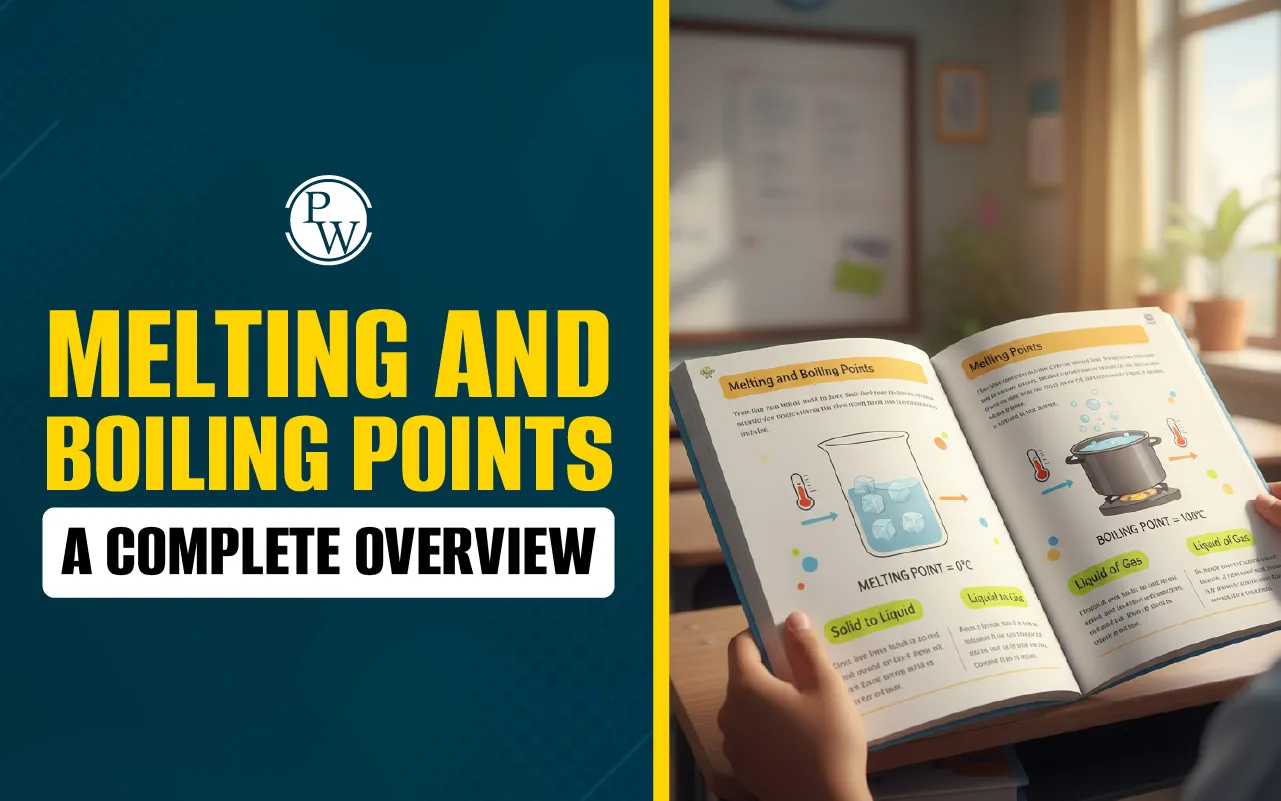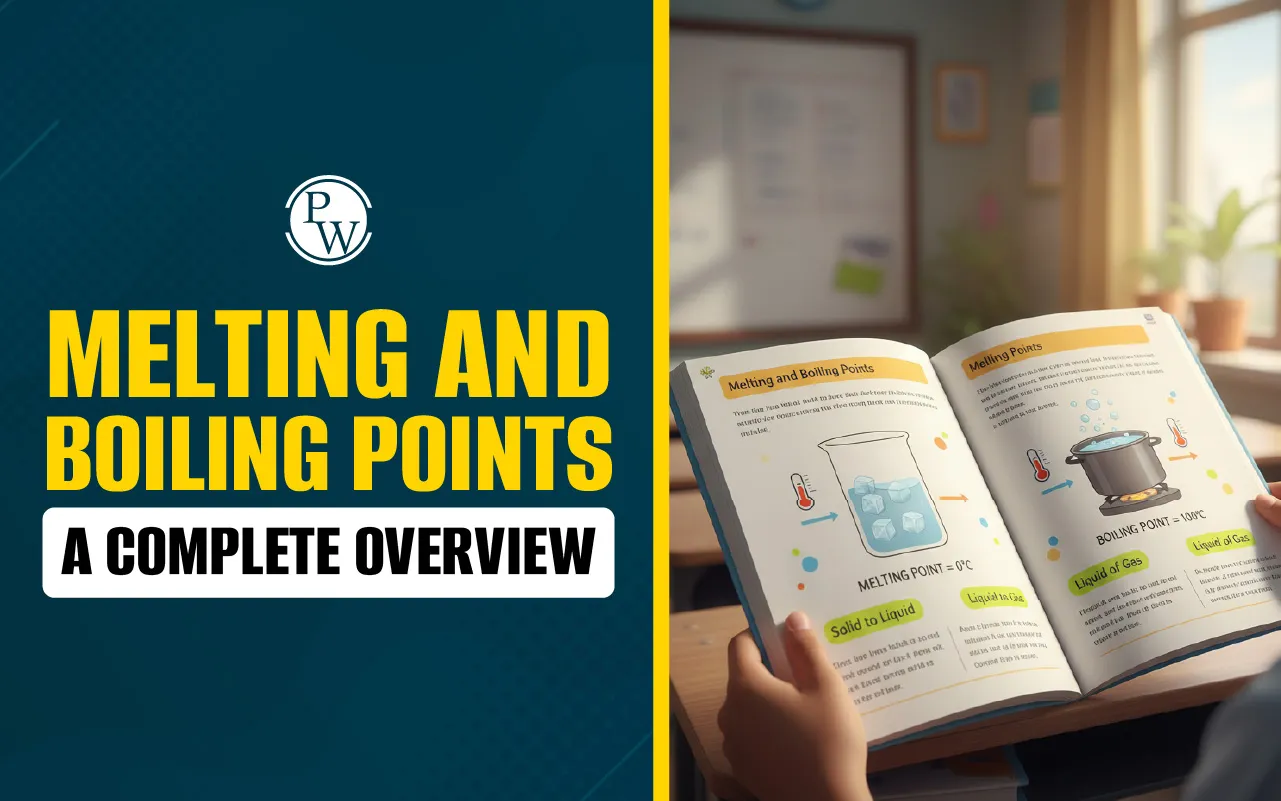

Melting and Boiling Points
Melting and boiling points are important concepts in science. They describe the behaviour of substances when they get hot or cold. The melting point informs us of when a solid is changed to a liquid, and the boiling point informs us of when a liquid is changed to a gas. Knowing these points will enable the students to learn the influence of temperature on matter.
These properties are used in many fields such as chemistry, physics, food processing, and industry. The melting and boiling point of a material are useful in determining materials, determining their purity, and their behavior when exposed to heat.
Read More: What is Temperature?
What is the Melting Point?
The melting point is a temperature at which a material is in liquid state and a given pressure. The particles of a solid begin to move more rapidly, and to no longer occupy their fixed positions when the solid is heated. The solid fuses at a particular temperature. This melting point is referred to as temperature.
Definition: The melting point of a substance is the temperature at which it turns into a liquid.
Both the liquid and the solid phases coexist briefly at the melting point. This is such that some of the substance remains solid but there are others that have melted into liquids.
Mixed melting points are commonly employed to determine the purity of substances in the laboratory. A pure substance melts abruptly whereas an impure substance melts within a range of temperatures.
What is the Boiling Point?
The boiling point definition states that it is the temperature at which a liquid changes into a gas when its vapor pressure equals the external pressure.
When a liquid is heated, its particles gain energy and move faster. Eventually, they have enough energy to escape from the surface as vapor. When bubbles of vapor start forming inside the liquid and rise to the surface, the liquid begins to boil. The temperature at which this happens is called the boiling point.
Definition: The temperature at which a liquid changes into a gas when its vapor pressure equals external pressure.
Boiling points are very important in separation processes like distillation, where liquids are separated based on their different boiling points.
Read More: Three States of Matter
Melting and Boiling Point Examples
The following melting and boiling point examples show the temperature at which different substances change their states.
|
Melting and Boiling Point Examples |
||
|
Substance |
Melting Point |
Boiling Point |
|
Water |
0°C |
100°C |
|
Ethanol |
-114°C |
78.37°C |
|
Iron |
1538°C |
2862°C |
|
Gold |
1064°C |
2856°C |
|
Sodium Chloride (Salt) |
801°C |
1413°C |
Read More: Heat and Temperature
Boiling Point Examples
The following are some detailed boiling point examples that show how different materials behave:
-
Boiling point of water: Water boils at 100°C at sea level. At higher altitudes, due to lower pressure, it boils at a slightly lower temperature, such as 95°C.
-
Boiling point of ethanol: Ethanol boils at 78.37°C. This property helps in separating ethanol from water through distillation.
-
Boiling point of mercury: Mercury boils at 356.7°C. This high boiling point makes it suitable for use in thermometers and barometers.
-
Boiling point of nitrogen: The boiling point of nitrogen is very low at -195.79C. It is applied in the freezing and preservation of biological samples.
-
Boiling point of salt solution: Salt solution boils at a higher temperature than pure water because of a phenomenon known as boiling point elevation. The dissolution of salt in water raises the boiling point due to the ions dissolved in the water.
These boiling point examples show how pressure, purity, and chemical composition affect the temperature at which a liquid turns into vapor.
Melting Point Examples
Below are some important melting point examples that show how solids change into liquids at specific temperatures:
-
Melting point of ice (water): The melting point of ice is 0°C. It is one of the most common examples we see every day when ice turns into water.
-
Melting point of gold: Gold melts at 1064°C. This property is important in jewelry making and metal industries.
-
Melting point of iron: Iron melts at 1538°C. It is used in the steel industry to make strong metal products.
-
Melting point of chocolate: Chocolate melts at around 30–32°C, which is why it easily melts in the mouth.
-
Mixed melting points: Mixed melting points are used in laboratories to test purity. If a sample is mixed with impurities, its melting point decreases and becomes less sharp.
These melting point examples help in understanding why substances behave differently when heated. Substances with strong molecular bonds require more heat energy to melt.
Read More: What is Photosynthesis?
Difference Between Melting and Boiling Points
Both melting and boiling points describe changes in the physical state of matter, but they represent different transitions.
|
Difference Between Melting and Boiling Points |
||
|
Aspect |
Melting Point |
Boiling Point |
|
Definition |
Temperature at which a solid becomes a liquid |
Temperature at which a liquid becomes a gas |
|
Phase Change |
Solid → Liquid |
Liquid → Gas |
|
Pressure Dependence |
Slightly affected by pressure |
Strongly affected by pressure |
|
Examples |
Ice melts at 0°C |
Water boils at 100°C |
|
Applications |
Used to identify solids and test purity |
Used in distillation, cooking, and industrial processes |
Make Science Learning Easy and Enjoyable with CuriousJr After-School Online Classes
Many students find science difficult because they do not get enough opportunities to ask questions or explore how things work in real life. This often leads to memorizing facts instead of truly understanding concepts.
CuriousJr’s Online Tuition Classesmake learning simple, fun, and interactive. Through exciting activities and clear explanations, students build a strong foundation and start enjoying science. These classes also cover Science, Maths, English, and Social Studies, following CBSE, ICSE, and State Board patterns.
Students learn through interactive live sessions that use visual aids, real-life examples, and hands-on activities. Each student gets personalised attention and dual mentorship, making it easier to understand lessons and clear doubts.
Lessons are concept-based, connecting science with everyday life for better understanding. Regular quizzes and practice sessions help improve memory and strengthen learning. Performance tracking and feedback guide students to grow, improve, and gain confidence.
Give your child the chance to learn with confidence and discover the joy of science with CuriousJr After-School Online Classes.
